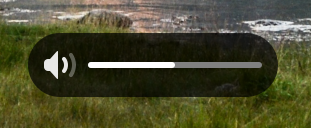A OSD window for common actions like volume and capslock.
This is my first time coding in Rust so fixes and improvements are appreciated :)
- LibInput listener Backend for these keys:
- Caps Lock
- Num Lock
- Scroll Lock
- Input and output volume change indicator
- Input and output mute change indicator
- Customizable maximum Volume
- Capslock change (Note: doesn't change the caps lock state)
- Brightness change indicator
There's a new LibInput watcher binary shipped with SwayOSD (swayosd-libinput-backend)
which can automatically detect key presses, so no need for binding key combos.
The supported keys are listed above in Features
# Please note that the command below might require `--prefix /usr` on some systems
meson setup build
ninja -C build
meson install -C buildAvailable on the AUR thanks to @jgmdev! (Don't open a issue here about AUR package)
Using Systemd: sudo systemctl enable --now swayosd-libinput-backend.service
Other users can run: pkexec swayosd-libinput-backend
# OSD server
exec swayosd-serveror start with a max-volume set (default is 100)
exec swayosd-server --max-volume 120# Sink volume raise optionally with --device
bindsym XF86AudioRaiseVolume exec swayosd-client --output-volume raise
# Sink volume lower optionally with --device
bindsym XF86AudioLowerVolume exec swayosd-client --output-volume lower --device alsa_output.pci-0000_11_00.4.analog-stereo.monitor
# Sink volume toggle mute
bindsym XF86AudioMute exec swayosd-client --output-volume mute-toggle
# Source volume toggle mute
bindsym XF86AudioMicMute exec swayosd-client --input-volume mute-toggle
# Volume raise with custom value
bindsym XF86AudioRaiseVolume exec swayosd-client --output-volume 15
# Volume lower with custom value
bindsym XF86AudioRaiseVolume exec swayosd-client --output-volume -15
# Sink volume raise with custom value optionally with --device
bindsym XF86AudioLowerVolume exec swayosd-client --output-volume +10 --device alsa_output.pci-0000_11_00.4.analog-stereo.monitor
# Sink volume lower with custom value optionally with --device
bindsym XF86AudioLowerVolume exec swayosd-client --output-volume -10 --device alsa_output.pci-0000_11_00.4.analog-stereo.monitor
# Capslock (If you don't want to use the backend)
bindsym --release Caps_Lock exec swayosd-client --caps-lock
# Capslock but specific LED name (/sys/class/leds/)
bindsym --release Caps_Lock exec swayosd-client --caps-lock-led input19::capslock
# Brightness raise
bindsym XF86MonBrightnessUp exec swayosd-client --brightness raise
# Brightness lower
bindsym XF86MonBrightnessDown exec swayosd-client --brightness lower
# Brightness raise with custom value
bindsym XF86MonBrightnessUp exec swayosd-client --brightness 10
# Brightness lower with custom value
bindsym XF86MonBrightnessDown exec swayosd-client --brightness -10- It is for audio devices only.
- If it is omitted the default audio device is used.
- It only changes the target device for the currrent action that changes the volume.
- You can list your input audio devices using
pactl list short sources, for outputs replacesourceswithsinks.
Some devices may not have permission to write /sys/class/backlight/*/brightness.
So using the provided packaged udev rules + adding the user to video group
by running sudo usermod -a -G video $USER, everything should work as expected.

